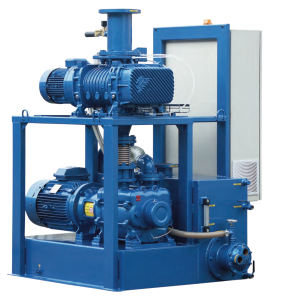While a hybrid vacuum pump is commonly referred to as a combination pump, because it is often uses the advantages of one vacuum component to overcome the disadvantages of another. A common example is either of a Liquid Ring vacuum pump or Rotary vane vacuum pump used as a second stage, with a first stage being steam ejectors, or air motivated ejectors in a complete Hybrid vacuum system.
Furthermore, with excessively high service liquid temperatures the efficiency of the liquid ring vacuum pump is reduced. With lower water temperature vacuum undefined pressure is increased as well as capacity. A steam ejector will cool the service liquid water and decrease the amount of condensable vapours entering the pump. This increases pumping capacity as it can handle the higher load.
The vacuum pumps can be used for hogging, advantageous where motive steam is not available during system start-up, and can also be sized to handle normal process operating requirements.
Steam requires higher energy consumption so the liquid ring pump has higher efficiency for most of the system operating cycle. When low absolute pressure operation is required, or when cooling water temperatures are too high for “vacuum pump only” operation, the steam or air ejector is used as a first-stage booster to extend the range of the vacuum system to the required vacuum and higher additional capacity in a very economical package, from both capital and utility requirements.
Laboratory vacuum systems often need higher vacuum levels in the range of 0.01 to 0.001 Torr and up. Hybrid vacuum systems using a Bora High Vacuum Booster is dry running vacuum pump, used in tandem with a backing pump, such as oil lubricated rotary vane pump. Another option for laboratory vacuum is a two stage rotary vane pump reaching end vacuum to 0.001 Torr. Agilent and BOC Edwards are two well known, high performance brands to look for.
A Condensate trap or water trap stops extremely high condensable vapor loads from entering rotary vane or piston pumps. Condensate traps in the inlet line of the pump trap condensable gases and remove them before entering the pump and causing problems. Excess vapors in the pump lead to reduced pump life, premature corrosion and deposits that build up in casing andotor over time and Damage to internal vanes.
After use, it is good practice to run the pump with the inlet closed and the gas ballast open. This helps purge any condensed vapors in the pump oil. A half hour is sufficient usually.
Condensate traps undefined Water traps work by adsorption of vapors to material undefined media placed in the vacuum suction line, cooling surfaces placed in the vacuum line or by a combination of both. Condensate traps require regular servicing to drain the condensed liquids, some provide automatic drain systems and automatic pump shut-off when traps reach and pass high level points. Water traps can be clear or have sight glasses to indicate when draining is required.
Inlet Filters with paper, poly or activated carbon and water traps also keep vacuum oil un-contaminated for longer periods of service. Filters help to avoid particulates. Particles entering the pump can score the walls of the pump, reducing its efficiency. Additionally, the particulate inside of the pump can also cause damage, setting off a chain of events leading to seizing and failure as well as long repair times if one does not have a back-up pump or an experienced pump repair shop at close quarters.
Some points to maintain:
Never block the pump discharge outlet. Back pressure on the pump reduces its efficiency, and can cause serious internal damage. Original manufacturer equipment oil mist filters are recommended.
For optimal performance, a number of things influence the performance of a combination hybrid vacuum pump. This is why conducting regular inspections is so important. This provides the opportunity to ensure there are no leaks in the system, including equipment and related accessories, such as downstream and upstream piping. Even with frequent inspections, this type of pump has a few common problems.
- Non-Starting Pump – Make sure the pump is properly connected and check the set motor protection switch. If the engine is not starting because the operating voltage does not match to the motor, the motor needs replacing. In addition, look at the oil temperature. If it is below 12 degrees Celsius, heat the pump or try using a different oil grade.
- Does Not Reach Optimal Pressure – The pump could have the wrong gauge or there is an external leak caused by loose-fitting pipes. This could also be caused from an improperly closing float valve, the filter could be dirty or clogged, the oil might be contaminated, or the lines need changing.
- Low Speed – This is often caused by trapped dirt in the intake. However, the exhaust filter could also be clogged, the connecting lines might be too long or narrow, or the length of the spring on the anti-suck-back valve prevents it from opening.
- Pressure Rises Too Fast – If the pressure rises too fast when the pump is switched off under vacuum, the system may have a leak or the anti-suck-back valve has malfunctioned and needs replacing.
At Premium Fluid Systems (PFS), we manufacture virtually all elements of a vacuum pump system design. Our trouble-shooting literature is thorough and has incorporated ISO 9001:2008 guidelines to give your maintenance personal easy access to pump problem solving. PFS trains customers at request to maintain their pumps or can offer maintenance service contracts if required. The Travaini Group has presence in every major Canadian province and most U.S. states.
For information about our company and what we do, please visit our website or call us today.

